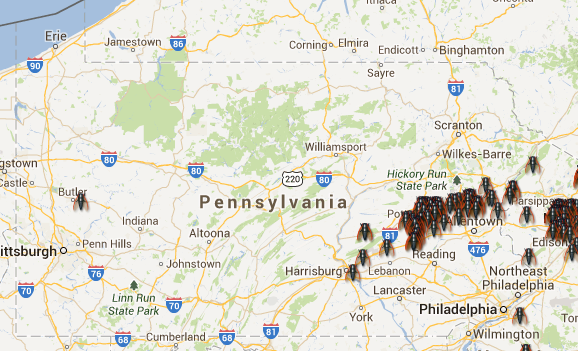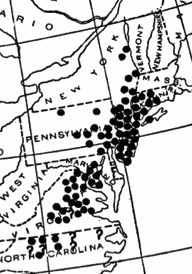At this point in the 2013 Brood II emergence, all the cicadas that will emerge, have emerged. I’m sorry to say that if periodical cicadas have not emerged in your yard/neighborhood/town, they won’t. This is frustrating for people who heard that the cicadas would emerge in their state or those who looked at a brood map and assumed their neighborhood fell within the area shown on the map.
People in Pennsylvania, for example, heard that cicadas would arrive in their state, but unfortunately, the cicadas only occupy a small banana-shaped region in the east of the state:

If you look at one of the older maps for Brood II, it looks like the state of New Jersey is covered, however, each dot might represent only one sighing in one specific area. These old maps are useful, but they can be misleading (more on maps later in this article).

Back in 2004, after Brood X emerged, I wrote an article called: What Happened: the Magicicada No-Show of 2004. The information in that article is relevant for Brood II as well.
The truth is periodical cicadas do not occupy every square acre of a state in which they are expected to emerge. Even in towns where they do emerge, they are rarely present in every acre or block of those towns. Why? Well, either they were eliminated in the areas where they once were found (due to urban sprawl, pesticides, weather-related events, etc), or they simply were never there in the first place. New threats like extreme weather (flooding and tree destruction by tropical storms) and tree-destroying invasive species (like the emerald ash borer) will continue to shrink cicada habitat areas.
It is important, for future emergences, that the press/media and cicada websites provide more accurate information about the location of the cicadas. The cicada sighting information people provide to Cicadas @ UCONN (formerly Magicicada.org) is very important because it will lead to better maps and more accurate sighting information.
One thing I’m glad that I did this year was to provide a page that listed specific towns in New Jersey where cicadas could be expected. I wish I did one for every state in the Brood II area [but Cicada Mania is not my day job, and there are only so many hours in a day].
That said, we never want to discourage people from looking for periodical cicadas in areas we don’t expect them to exist. Last year unexpected Brood I cicadas emerged in Tennessee. This year periodical cicadas unexpectedly emerged in Oklahoma. A lot of us were hoping cicadas would show up in Central Park in Manhattan, but they didn’t (however, I didn’t personally walk every acre of the park).
So, what can you do to help?
- If you’re a member of the press/media (yes that includes bloggers and tweeters), make sure you get precise locations from cicada experts.
- Report cicada and flagging sightings to Cicadas @ UCONN (formerly Magicicada.org) so we have better records of the emergence.
- Help cicada research by participating in a cicada community science project.
- Help preserve the current cicada habitat. Preserve trees. Avoid pesticides. Don’t wipe out another forest to add yet another redundant giant store.
A consolation for people who missed out on the 17 year cicadas: there are about 160 species of annual cicadas in North America. They’re usually harder to find and catch, but you can still hear and capture them if you put some time and effort into it.
6 replies on “Where’s the cicadas?”
I was lucky enough to see them on my only visit to US, in Blairsville, north Georgia, the 20.th of May 2013. They were utterly fascinating, but when they emerged on the porch I had no idea what they were and I had never heard of the phenomenon before. I managed to get some pretty good photos.
Thank you so much for that post about where to find cicadas in the Hudson Valley. I drove from Poughkeepsie to Germantown a couple of weeks and didn’t see any. I thought it was too late. Maybe it was too early.
Today I went to the spot you recommended on Rte. 199. There weren’t “hundreds” there any more, but there were lots. I’m so glad I finally got to see (and photograph) them.
There is just one more thing I forgot to ask regarding this post. I am wondering if the record keeping that is requested on cicada sighting is used at all for conservation purposes. Certainly it helps to know where cicadas are found and to get estimates of their numbers and other signs, but how is this information helpful if the land itself remains vulnerable to development or the whims of uncaring landowners? If the cicadas are verified, are there any sure ways of ensuring their protection over the next 13 or 17 years, or will this only happen if the insects become threatened or endangered?
Thanks again.
It isn’t common to see all three in the same area, so it is a little special.
Thank you Dan for providing information on the answer to the question of why periodical cicadas appear in large numbers in some places but not others within a state or region. I have been wondering about the answer for awhile.
Periodical cicadas have not appeared in large numbers in my yard, but I have seen them concentrated around a few trees in nearby neighborhoods and in even larger concentrations on some nearby properties. I have discovered one area where I have located all three periodical cicadas, and I am wondering is it common to see all three in an area, or does this mean a location is particularly special or valuable for the population?
Thanks again for continuing to provide such informative information on your website. I only wish more people would read it and stop using so many lawn chemicals in my neighborhood here in NJ.
Good points, Dan. Especially about recording and preserving periodic cicada habitat for future generations. Even specific trees could be marked as protected, perhaps with a fence or at least a sign, explaining its importance. Imagine protectimg a tree or small local area from pesticides, paving, and pruning for the next 17 years! An oasis in the midst of development and an educational learning site for all ages. Perhaps your website could put together a sign that us citizen scientists could print and post, to help protect these amazing creatures while they are invisibly metamorphosing below us, unbeknownst to most people… I for one will be eager to help in this campaign to Save Our Cicadas 🙂